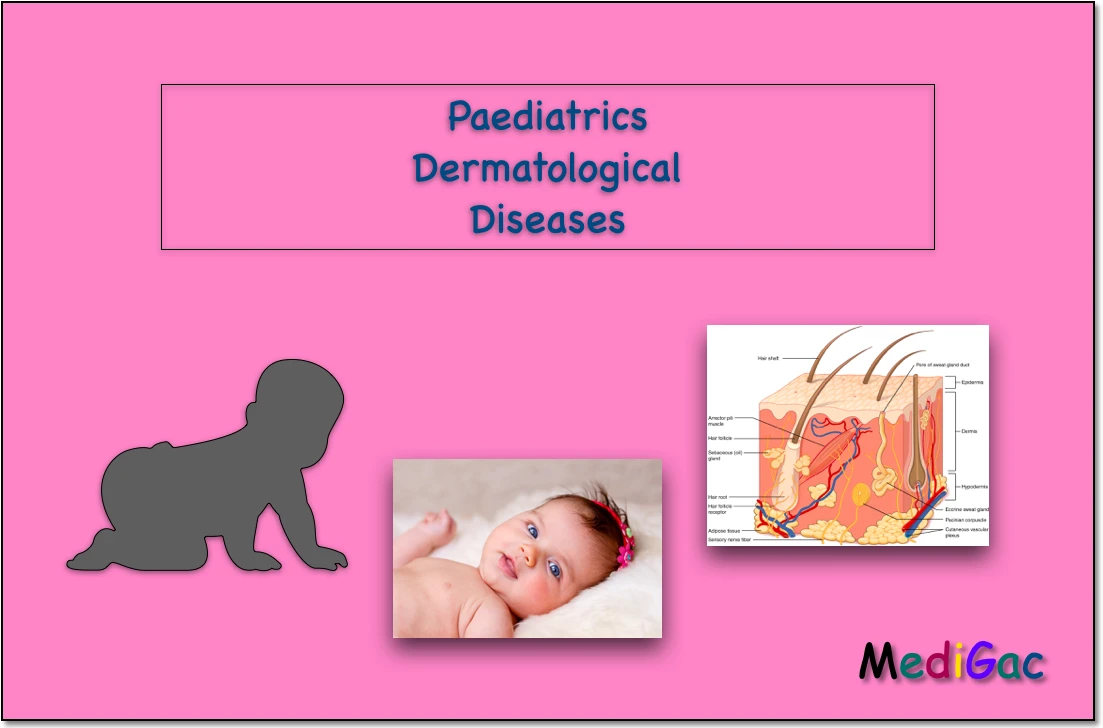
Paediatrics/Newborn baby/neonates/childrens dermatological or skin related conditions-disorders-diseases examinations. Abnormal facies are also discussed. We have discussed total five main topics under this post, and they are :
- What are the congenital diseases/disorders
- What are the infective diseases/disorders
- What are the allergic/Immunogenic diseases or disorders
- What are the other diseases or disorders
Skin and hair related diseases/disorders :

There can be four types of paediatrics dermatological diseases or disorders – Congenital, Infective, Allergic/Immunogenic and others. We have discussed one by one in details description with all diseases.
I. What are the congenital diseases/disorders :
1. Pigmentation :
Brown and Grey Pigmented Baby Birthmarks Extra melanocytes—the cells that create pigment (colour) in the skin—can cause brown and grey birthmarks. Pigmented birthmarks can differ in appearance and behaviour. Some are safe, but others may cause health issues for your child.
2. Hypopigmentation :
Hypopigmented macules, often known as “ash-leaf patches,” are most common on the trunk and lower extremities and can be present at birth. They occur in 80 percent of tuberous sclerosis patients by the age of one year. As a result, they are the first signs of the illness.
3. Vascular malformation :
Extra blood vessels make up a lot of pink, red, and blue birthmarks. Some vascular birthmarks can feel warm to the touch due to the excess blood. Depending on the type of blood vessels present, vascular birthmarks may appear and act differently. The following are the most frequent blood vessel birthmarks :
- Nevus simplex : This includes “salmon patch”, “angle kiss”, “Stork bite”.
4. Xeroderma pigmentosum :
Xeroderma pigmentosum, or XP, is a hereditary disorder marked by a high sensitivity to ultraviolet (UV) rays from the sun. This illness primarily affects the eyes and sun-exposed parts of the skin. Some people who are impacted also have problems with their nervous systems.
II. What are the Infective diseases/disorders :
1. Bacterial :
- Impetigo – Impetigo is a bacterial infection of the skin. It starts as blisters on the baby’s skin near his or her nose and mouth, then spreads to other body areas. The size of the blisters is determined by the type of Impetigo that the baby has.
- Boils – These can develop when germs infect your child’s hair follicle as a result of shaving or itching. Take your child to the doctor right away if the boil lasts more than two weeks, is particularly painful or huge, or if the child has a fever.
- Salmonella typhi infection – Salmonella typhi infection is a major public health concern around the world. It has a huge impact on millions of people and has a high mortality rate. Because there is less chance of vertical or horizontal transmission in newborn babies, they are less likely to get Salmonella.
- Skin rash – Rashes on newborns are frequent, and the majority of them do not require medical attention. Rashes, like eczema, are hereditary and can be treated with a moisturising treatment. Environmental variables such as heat and allergens can also cause a rash in babies.
2. Viral :
- Chicken pox – The varicella-zoster virus causes chickenpox, which is a contagious infection.
- Measles – A hacking cough, runny nose, high fever, and red eyes are frequently the first signs of a measles infection. Before the rash appears, children may develop Koplik’s spots (little red patches with blue-white centres) within their mouth.
- Rubella – Rubella normally causes only a slight rash and minor respiratory problems in babies and toddlers. However, it can be a life-threatening illness for a kid in the womb. It has the potential to cause miscarriage or birth abnormalities.
3. Fungal :
- Tinea capitis – Tinea capitis is a fungal infection in the skin of the hair, also known as ringworm or herpes tonsurans infection. It is mainly caused by the Microsporum and Trichophyton dermatophyte species. The fungi can penetrate the outer root of the hair follicle and eventually invade the hair shaft.
III. What are the allergic/immunogenic diseases/disorders :
1. Urticaria :
Hives (urticaria) are red, itchy, skin reaction welts. The soles vary in size and repeatedly appear and fade as the reaction goes on. Chronic hives are considered if the surfactants appear for more than 6 weeks and often recur over months or years.
2. Atomic dermatitis/eczema :
The most common form of eczema is atopic eczema (atopic dermatitis), which causes the skin to itch, dry, and crack. In children atopic eczema is more prevalent, often pre-birthday. However, it can also develop in adults for the first time.
3. Steven Johnson syndrome :
SJS is a rare, serious disorder of the skin and mucous membrans. Stevens-Johnson Syndrome is common. It is generally a drug reaction, which is followed par a painful rash which spreads and blisters with flu-like symptoms. Then die, dump, and start to heal the top layer of the affected skin after several days.
IV. What are the Others diseases/disorders :
1. Kawasaki disease :
In the walls of medium-sized arteries, Kawasaki disease causes swelling (inflammation) throughout the body. It affects children in particular. The inflammation tends to affect the coronary arteries that supply the heart muscle with blood
2. Ecchymosis :
Blood or bloody skin due to any type of trauma; usually black and blue, with change in colour as the treatment progresses.
3. Purpuric spots :
Purpura, also known as blood spots or skin haemorrhages, is the most recognisable purple spot on skin. Spots on organ or mucous membranes, including membranes inside the mouth, may also appear. Purpura occurs when small blood vessels explode and blood pools beneath the skin.